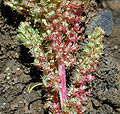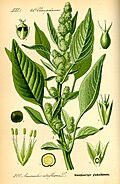Template:Otheruses Template:Redirect5 Template:Taxobox
The amaranths (also called pigweeds) comprise the genus Amaranthus, a widely distributed genus of short-lived herbs, occurring mostly in temperate and tropical regions. Although there remains some confusion over the detailed taxonomy, there are about 60 Amaranthus species. Several of them are cultivated as leaf vegetables, cereals, or ornamental plants.
Members of this genus share many characteristics and uses with members of the closely related genus Celosia.
Cultivation and uses
Several species are raised for amaranth grain in Asia and the Americas. Amaranth grain is a crop of moderate importance in the Himalaya. It was one of the staple foodstuffs of the Incas, and it is known as kiwicha in the Andes today. It was also used by the ancient Aztecs, who called it huautli, and other Amerindian peoples in Mexico to prepare ritual drinks and foods. To this day, amaranth grains are toasted much like popcorn and mixed with honey or molasses to make a treat called alegría (literally "joy") in Mexican Spanish.
Amaranth was used in several Aztec ceremonies, where images of their gods (notably Huitzilopochtli) were made with amaranth mixed with honey. The images were cut to be eaten by the people. This looked like the Christian communion to the Catholic priests, so the cultivation of the grain was forbidden for centuries.
Because of its importance as a symbol of indigenous culture, and because it is very palatable, easy to cook, and its protein particularly well suited to human nutritional needs, interest in grain amaranth (especially A. cruentis and A. hypochondriaca) was revived in the 1970s. It was recovered in Mexico from wild varieties and is now commercially cultivated. It is a popular snack sold in Mexico City and other parts of Mexico, sometimes mixed with chocolate or puffed rice, and its use has spread to Europe and North America. Besides protein, amaranth grain provides a good source of dietary fiber and dietary minerals such as iron, magnesium, phosphorus, copper, and especially manganese.
The flowers of the Hopi Red Dye amaranth were used by the Hopi Indians as the source of a deep red dye. This dye has been supplanted by a coal tar dye known as Red No. 2 in North America and E123 in the E.E.C., also known as amarynth.
The genus also contains several well-known ornamental plants, such as A. caudatus (love-lies-bleeding), a native of India and a vigorous, hardy annual with dark purplish flowers crowded in handsome drooping spikes. Another Indian annual, A. hypochondriacus (prince's feather), has deeply-veined lance-shaped leaves, purple on the under face, and deep crimson flowers densely packed on erect spikes.
Amaranths are recorded as food plants for some Lepidoptera species including The Nutmeg and various case-bearers of the genus Coleophora: C. amaranthella, C. enchorda (feeds exclusively on Amaranthus), C. immortalis (feeds exclusively on Amaranthus), C. lineapulvella and C. versurella (recorded on A. spinosus).
Use in South-East Asia
In Indonesia, Malaysia and China, species of amaranth are cultivated and consumed as a leaf vegetable, and are called by the name bayam.[1]Template:Fact It is commonly but incorrectly translated to and from English as spinach (including in Popeye cartoons) but is a different plant.
Amaranth as weed
Not all amaranth plants are cultivated. Some appear as weeds. A new strain of the Palmer amaranth has appeared which is glyphosate-resistant and as a result cannot be killed by the widely used Roundup herbicide. This could be of particular concern to cotton farmers using Roundup Ready cotton.[2]
Nutritional value
Amaranth greens, also called Chinese spinach, hinn choy or yin tsoi (Template:Zh-sp), callaloo, tampala, or quelite, are a common leaf vegetable throughout the tropics and in many warm temperate regions. They are a very good source of vitamins including vitamin A, vitamin B6, vitamin C, riboflavin, and folate, and dietary minerals including calcium, iron, magnesium, phosphorus, potassium, zinc, copper, and manganese. However their moderately high content of oxalic acid inhibits the absorption of calcium, and also means that they should be avoided or eaten in moderation by people with kidney disorders, gout, or rheumatoid arthritis.
Amaranth seeds, like buckwheat and quinoa, contain protein that is unusually complete for plant sources [3]. Most plants do not contain a complete set of amino acids, and thus are inadequate for human survival, which is why vegetarians must make special efforts to combine the right plants and get a full protein. This is the reason for the traditional "beans and rice" combination, which creates a more nutritionally complete meal.
Myth, legend and poetry
Amaranth, or Amarant (from the Greek amarantos, unwithering), a name chiefly used in poetry, and applied to Amaranth and other plants which, from not soon fading, typified immortality. Thus, in Milton's Paradise Lost, iii. 353:
- "Immortal amarant, a flower which once
- In paradise, fast by the tree of life,
- Began to bloom; but soon for man's offence
- To heaven removed, where first it grew, there grows,
- And flowers aloft, shading the fount of life,
- And where the river of bliss through midst of heaven
- Rolls o'er elysian flowers her amber stream:
- With these that never fade the spirits elect
- Bind their resplendent locks."
Samuel Taylor Coleridge, in Work without Hope (1825), also references the herb, likely referencing Milton's earlier work. (ll 7-10 excerpted):
- Yet well I ken the banks where Amaranths blow,
- Have traced the fount whence streams of nectar flow.
- Bloom, O ye Amaranths! bloom for whom ye may,
- For me ye bloom not! Glide, rich streams, away!
The progessive metal band, Opeth, refers to Amaranth in the extent of immortallity in the song Blackrose Immortal:
- "Lullaby of the crescent moon took you
- Mesmerized, its kaleidoscopic face
- Granted you a hollow stare
- Another soul within the divine herd
- I have kept it
- The amaranth symbol
- Hiddin inside the golden shrine
- Until we rejoice in the meadow
- Of the end
- When we both walk the shadows
- It will set ablaze and vanish
- Black rose immortal"
Aesop's Fables compares the Rose to the Amaranth to illustrate the difference in fleeting and everlasting beauty.
- A Rose and an Amaranth blossomed side by side in a garden,
- and the Amaranth said to her neighbour,
- "How I envy you your beauty and your sweet scent!
- No wonder you are such a universal favourite."
- But the Rose replied with a shade of sadness in her voice,
- "Ah, my dear friend, I bloom but for a time:
- my petals soon wither and fall, and then I die.
- But your flowers never fade, even if they are cut;
- for they are everlasting."
The original spelling is amarant; the more common spelling amaranth seems to have come from a folk etymology assuming that the final syllable derives from the Greek word anthos ("flower"), common in botanical names.
In ancient Greece the amaranth (also called chrusanthemon and elichrusos) was sacred to Ephesian Artemis. It was supposed to have special healing properties, and as a symbol of immortality was used to decorate images of the gods and tombs. In legend, Amarynthus (a form of Amarantus) was a hunter of Artemis and king of Euboea; in a village of Amarynthus, of which he was the eponymous hero, there was a famous temple of Artemis Amarynthia or Amarysia (Strabo x. 448; Pausan. i. 31, p. 5).
Amaranth is also the name of the otherworldly pantheon that amuses itself by toying with individuals' luck in Tim Lebbon's novella "The Unfortunate".
"Amaranth" is also the name of a long Sapphic poem by the great imagiste H.D., and is based on Sappho's fragment 131.
In White Wolf Game Studio's Vampire: The Dark Ages books and role-playing games, Amaranth is the medieval name of what then was widely known as Diablerie (consuming the blood and soul of another vampire).
Amarantine is the name of a 2005 album and single by Irish vocal artist Enya.
"Love-Lies-Bleeding" is the title of a 2005 play by Don DeLillo.
In Garth Nix's novel Abhorsen, the third chapter is entitled "Amaranth, Rosemary and Tears".
"Amaranth" is also the title of a music cd by composer Robert Agis.
Selected species
- Amaranthus acanthochiton (Greenstripe)
- Amaranthus acutilobius (Sharplobe Amaranth)
- Amaranthus albus (White Pigweed, Prostrate Pigweed, Pigweed Amaranth)
- Amaranthus arenicola (Sandhill Amaranth)
- Amaranthus australis (Southern Amaranth)
- Amaranthus bigelovii (Bigelow's Amaranth)
- Amaranthus blitoides (Mat Amaranth, Prostrate Amaranth, Prostrate Pigweed)
- Amaranthus blitum (Purple Amaranth)
- Amaranthus brownii (Brown's Amaranth)
- Amaranthus californicus (California Amaranth, California Pigweed)
- Amaranthus cannabinus (Tidal-marsh Amaranth)
- Amaranthus caudatus (Loves-lies-bleeding, Pendant Amaranth, Tassel Flower, Quilete)
- Amaranthus chihuahuensis (Chihuahuan Amaranth)
- Amaranthus chlorostachys
- Amaranthus crassipes (Spreading Amaranth)
- Amaranthus crispus (Crispleaf Amaranth)
- Amaranthus cruentus (Purple Amaranth, Red Amaranth, Mexican Grain Amaranth)
- Amaranthus deflexus (Large-fruit Amaranth)
- Amaranthus dubius (Spleen Amaranth, Khada Sag)
- Amaranthus fimbriatus (Fringed Amaranth, Fringed Pigweed)
- Amaranthus floridanus (Florida Amaranth)
- Amaranthus gangeticus L
- Amaranthus greggii (Gregg's Amaranth)
- Amaranthus hybridus (Smooth Amaranth, Smooth Pigweed, Red Amaranth)
- Amaranthus hypochondriacus (Prince-of-Wales-feather, Princess Feather)
- Amaranthus leucocarpus
- Amaranthus lineatus (Australian Amaranth)
- Amaranthus lividus
- Amaranthus mantegazzianus (Quinoa de Castilla)
- Amaranthus minimus
- Amaranthus muricatus (African Amaranth)
- Amaranthus obcordatus (Trans-Pecos Amaranth)
- Amaranthus palmeri (Palmer's Amaranth, Palmer Pigweed, Carelessweed)
- Amaranthus paniculus (Reuzen Amaranth)
- Amaranthus polygonoides (Tropical Amaranth)
- Amaranthus powelii (Green Amaranth, Powell Amaranth, Powell Pigweed)
- Amaranthus pringlei (Pringle's Amaranth)
- Amaranthus pumilus (Seaside Amaranth)
- Amaranthus quitensis (Ataco, Sangorache)
- Amaranthus retroflexus (Red-root Amaranth, Redroot Pigweed, Common Amaranth)
- Amaranthus rudis (Tall Amaranth, Common Waterhemp)
- Amaranthus scleropoides (Bone-bract Amaranth)
- Amaranthus spinosus (Spiny Amaranth, Prickly Amaranth, Thorny Amaranth)
- Amaranthus standleyanus
- Amaranthus thunbergii (Thunberg's Amaranth)
- Amaranthus torreyi (Torrey's Amaranth)
- Amaranthus tricolor (Joseph's-coat)
- Amaranthus tuberculatus (Rough-fruit Amaranth, Tall Waterhemp)
- Amaranthus viridis (Slender Amaranth, Green Amaranth)
- Amaranthus watsonii (Watson's Amaranth)
- Amaranthus wrightii (Wright's Amaranth)
References and external links
- Lenz, Botanik der alt. Greich. und Rom. Botany of old. (1859)
- J. Murr, Die Pflanzenwelt in der griech. Mythol. Plants in Greek Mythology. (1890)
- Amaranthus hybridus
- Amaranthus spinosus
- Amaranthus viridis
- Flora online : Flora of North America
- Amaranthus Info
- Alternate Field Crops Manual
Seabeach amaranth (A. pumilus), an endangered species of amaranth
- Amaranthus spinosus c.jpg
Callaloo (Amaranthus spinosus "calaloo")
cs:Laskavec de:Amarant (Pflanzengattung) es:Amaranthus eo:Amaranto nutraĵa fr:Amarante (plante) id:bayam it:Amaranto (alimento) lt:Burnotis ms:Bayam nah:Huauhtli nl:Amarant (geslacht) pl:Szarłat






